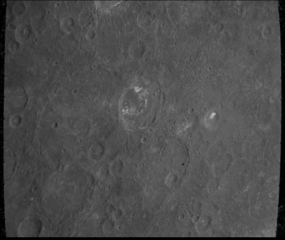
Abu Nuwas is an impact crater on the planet Mercury, 116 kilometers in diameter. It is located at 17.4°N, 20.4°W. It is named after the Arab poet Abu Nuwas, and its name was approved by the International Astronomical Union in 1976. There is small central peak in the center of the floor of Abu Nuwas, and bright features known as hollows are present near the peak.
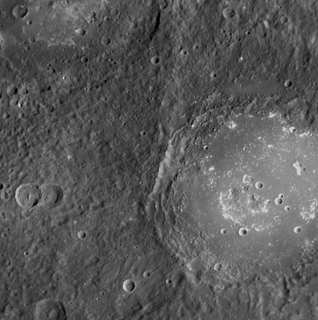
Lermontov is an impact crater on the planet Mercury, 152 kilometers in diameter. It is located at 15.2°N, 48.1°W, southwest of the crater Proust and northeast of the crater Giotto. It has a circular rim and a flat crater floor. The crater is named after Mikhail Yuryevich Lermontov, a 19th-century Russian poet. The name was approved by the International Astronomical Union in 1976.
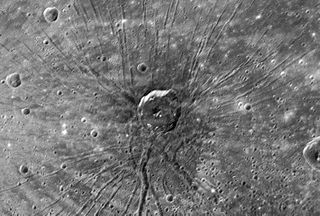
Apollodorus is an impact crater on Mercury. Its unusual appearance, with radiating dark troughs, led to a nickname of "the Spider" by scientists before its official name was decided. Apollodorus is located near the center of Pantheon Fossae, which is a system of radial grabens situated in the inner part of the Caloris basin. The floor, rim and walls of Apollodorus expose a low reflectance material (LRM) excavated during the impact from beneath the light volcanic plains, which cover the central part of the Caloris.

Located in the western edge of Mercury's giant Caloris basin, Kertész crater has some unusual, bright material located on its floor. Sander crater, located in the northwestern edge of Caloris basin, also shows bright material on its floor. Just northeast of Kertész a small crater has very bright rays and ejecta, indicating that the crater is young.

Praxiteles is a crater on Mercury. It is one of many peak-ring basins on Mercury.

Scarlatti is a pit-floored crater on Mercury, which was discovered in 1974 by the Mariner 10 spacecraft. It has a prominent peak ring, which floor is covered by the smooth plain material. The crater displays an arcuate collapse feature along the northeastern peak ring. The size of the pit, which was first noticed in MESSENGER images obtained in January 2008, is 38 × 12 km. Such a feature may have resulted from collapse of a magma chamber underlying the central peak ring complex of the crater. The collapse feature is an analog of Earth's volcanic calderas. Scarlatti is thought to have the same age as the Caloris basin.

De Graft is a crater on Mercury. Its name was adopted by the International Astronomical Union in 2009, after Ghanaian playwright, poet, and novelist Joe de Graft.

Ahmad Baba is a crater on Mercury. It has a diameter of 127 kilometers. Its name was adopted by the International Astronomical Union (IAU) in 1979.

Aksakov is a crater on Mercury. It has a diameter of 174 kilometers. Its name was adopted by the International Astronomical Union (IAU) on April 24, 2012. Aksakov is named for the Russian author Sergey Aksakov, who lived from 1791 to 1859 C.E.
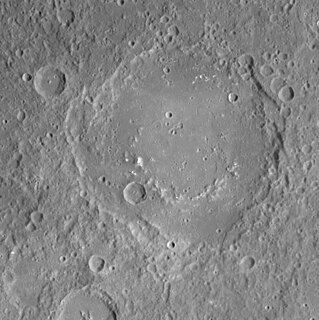
Al-Hamadhani is a crater on Mercury. It has a diameter of 186 kilometers. Its name was adopted by the International Astronomical Union in 1979. Al-Hamadhani is named for the Iranian writer Badi' al-Zaman al-Hamadani, who died in 1007 C.E.

Balzac is a crater on Mercury. Its name was adopted by the International Astronomical Union in 1976. Balzac is named for the French writer Honoré de Balzac, who lived from 1799 to 1850.

Bramante is a crater on Mercury. It has a diameter of 156 kilometers. Its name was adopted by the International Astronomical Union in 1976. Bramante is named for the Italian architect Donato Bramante, who lived from 1444 to 1514.

Darío is a crater on Mercury. It has a diameter of 151 kilometers. Its name was adopted by the International Astronomical Union (IAU) in 1976. Dario is named for the Nicaraguan poet Rubén Darío, who lived from 1867 to 1916.

Dürer is a crater on Mercury. It has a diameter of 195 kilometers. Its name was adopted by the International Astronomical Union (IAU) in 1976. Durer is named for the German artist Albrecht Dürer, who lived from 1471 to 1528.

Geddes is a crater on Mercury. It has a diameter of 84 kilometers. Its name was adopted by the International Astronomical Union (IAU) in 2010. Geddes is named for the Irish stained glass artist Wilhelmina Geddes, who lived from 1887 to 1955.

Hitomaro is a crater on Mercury. It has a diameter of 105 kilometers. Its name was adopted by the International Astronomical Union (IAU) in 1976. Hitomaro is named for the Japanese poet Kakinomoto no Hitomaro, who lived from the 650s to roughly 709.
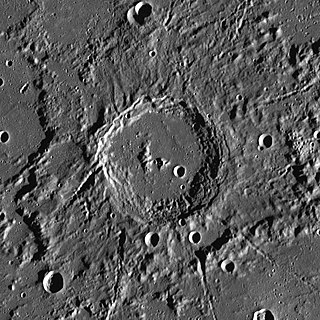
Mansur is a crater on Mercury. Its name was adopted by the International Astronomical Union in 1979. Mansur is named for the Indian artist Ustad Mansur, who lived in the 17th century CE.
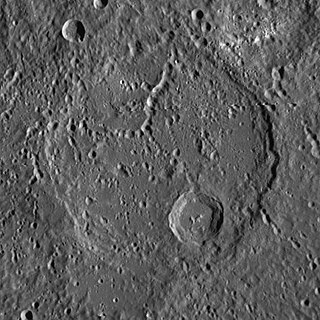
Sophocles is a crater on Mercury. Its name was adopted by the International Astronomical Union in 1976, after the Greek dramatist Sophocles.
Hollows are a landform on the planet Mercury, discovered during the MESSENGER mission that orbited the planet from 2011 to 2015.

Baranauskas is a crater on Mercury. It has a diameter of 36 kilometres. Its name was adopted by the International Astronomical Union (IAU) on September 25, 2015. Baranauskas is named for the Lithuanian poet Antanas Baranauskas.

